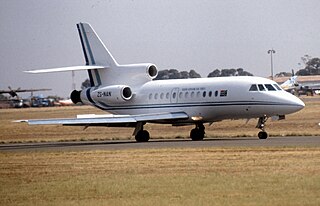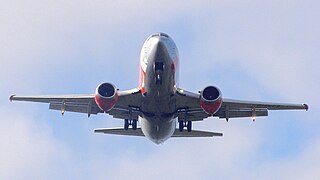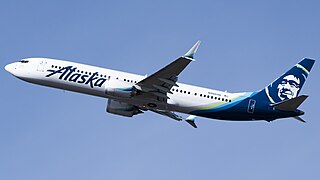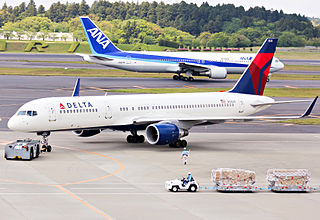
The Boeing 777, commonly referred to as the Triple Seven, is an American long-range wide-body airliner developed and manufactured by Boeing Commercial Airplanes. The 777 is the world's largest twinjet and the most-built wide-body airliner. The jetliner was designed to bridge the gap between Boeing's other wide body airplanes, the twin-engined 767 and quad-engined 747, and to replace aging DC-10 and L-1011 trijets. Developed in consultation with eight major airlines, the 777 program was launched in October 1990, with an order from United Airlines. The prototype was rolled out in April 1994, and first flew in June. The 777 entered service with the launch operator United Airlines in June 1995. Longer-range variants were launched in 2000, and first delivered in 2004.

The Boeing 737 is an American narrow-body airliner produced by Boeing at its Renton factory in Washington. Developed to supplement the Boeing 727 on short and thin routes, the twinjet retained the 707 fuselage width and six abreast seating but with two underwing turbofans instead of four. Envisioned in 1964, the initial 737-100 made its first flight in April 1967 and entered service in February 1968 with Lufthansa. The lengthened 737-200 entered service in April 1968, and evolved through four generations, offering several variants for 85 to 215 passengers.

A wide-body aircraft, also known as a twin-aisle aircraft and in the largest cases as a jumbo jet, is an airliner with a fuselage wide enough to accommodate two passenger aisles with seven or more seats abreast. The typical fuselage diameter is 5 to 6 m. In the typical wide-body economy cabin, passengers are seated seven to ten abreast, allowing a total capacity of 200 to 850 passengers. Seven-abreast aircraft typically seat 160 to 260 passengers, eight-abreast 250 to 380, nine- and ten-abreast 350 to 480. The largest wide-body aircraft are over 6 m (20 ft) wide, and can accommodate up to eleven passengers abreast in high-density configurations.

The Boeing 787 Dreamliner is an American wide-body airliner developed and manufactured by Boeing Commercial Airplanes. After dropping its unconventional Sonic Cruiser project, Boeing announced the conventional 7E7 on January 29, 2003, which focused largely on efficiency. The program was launched on April 26, 2004, with an order for 50 aircraft from All Nippon Airways (ANA), targeting a 2008 introduction. On July 8, 2007, a prototype 787 without major operating systems was rolled out; subsequently the aircraft experienced multiple delays, until its maiden flight on December 15, 2009. Type certification was received in August 2011, and the first 787-8 was delivered in September 2011 before entering commercial service on October 26, 2011, with ANA.

21 Squadron SAAF is a squadron of the South African Air Force. It was formed as a bomber squadron in Kenya during World War II and became a VIP transport squadron in the 1960s, a role which it performs to this day. The squadron currently flies two Dassault Falcon 50s, two Cessna Citation Is, a Dassault Falcon 900 and a Boeing BBJ aircraft. 21 Squadron is one of the most active squadrons in the air force with 606 VIP transport flights being made between 2009 and 2012. The Boeing BBJ is used as the presidential aircraft when the President of South Africa travels and designated callsign LMG1.

Boeing Commercial Airplanes (BCA) is a division of the Boeing Company. It designs, assembles, markets, and sells commercial aircraft, including the 737, 767, 777, and 787, along with freighter and business jet variants of most. The division employs nearly 35,000 people, many working at the company's division headquarters in Renton, Washington or at more than a dozen engineering, manufacturing, and assembly facilities, notably the Everett Factory and Renton Factory, and the South Carolina Factory.

The Boeing 747-8 is the final series of the large, long-range wide-body airliners in the Boeing 747 family from Boeing Commercial Airplanes. The 747-8 is the largest variant of the 747 and Boeing's largest aircraft. After introducing the 747-400, Boeing considered larger 747 versions as alternatives to the proposed double-deck Airbus A3XX, later developed as the Airbus A380. The stretched 747 Advanced was launched as the 747-8 on November 14, 2005, for a market forecast of 300 aircraft. The first 747-8F Freighter performed its maiden flight on February 8, 2010, and the passenger 747-8I Intercontinental followed suit on March 20, 2011. The cargo version was first delivered in October 2011 and the airliner began commercial service in June 2012.

A twinjet or twin-engine jet is a jet aircraft powered by two engines. A twinjet is able to fly well enough to land with a single working engine, making it safer than a single-engine aircraft in the event of failure of an engine. Fuel efficiency of a twinjet is better than that of aircraft with more engines. These considerations have led to the widespread use of aircraft of all types with twin engines, including airliners, fixed-wing military aircraft, and others.
Air transports for heads of state and government are, in many countries, provided by the air force in specially equipped airliners or business jets. One such aircraft in particular has become part of popular culture: Air Force One, used by the President of the United States and operated by the United States Air Force. Other well-known official aircraft include the Russian presidential aircraft, the British Royal Air Force VIP aircraft, the French Cotam 001, the Royal Canadian Air Force VIP aircraft, the German Konrad Adenauer, the Royal Australian Airforce VIP aircraft, the Japanese Air Force One, the South Korean Code One, the Indian Air India One, the Brazilian Air Force One, and the Israeli Wing of Zion.

The Royal Australian Air Force operates a number of specialised aircraft to transport the King of Australia and other members of the Royal family, the Governor General of Australia, the Prime Minister of Australia, senior members of the Australian government and other dignitaries.

The Boeing Everett Factory, officially the Everett Production Facility, is an airplane assembly facility operated by Boeing in Everett, Washington, United States. It sits on the north side of Paine Field and includes the largest building in the world by volume at over 472 million cubic feet (13,400,000 m3) and covers 98.3 acres (39.8 ha).

The Boeing 737 Next Generation, commonly abbreviated as 737NG, or 737 Next Gen, is a twin-engine narrow-body aircraft produced by Boeing Commercial Airplanes. Launched in 1993 as the third generation derivative of the Boeing 737, it has been produced since 1997.
The Emirates fleet is composed of two wide-bodied aircraft families, the Airbus A380 and Boeing 777. The airline also has the Airbus A350-900, Boeing 777X and Boeing 787 aircraft on order.

Air India One is the air traffic control call sign of any Special Extra Section Flight (SESF) operated by the Indian Air Force (IAF) for the President, Vice-President or Prime Minister of India. Ministry of Defence and AHQCS, based at Palam Air Force Station, New Delhi are responsible for coordinating and carrying out the missions.

The Boeing 737 MAX is the fourth generation of the Boeing 737, a narrow-body airliner manufactured by Boeing Commercial Airplanes, a division of American company Boeing. It succeeds the Boeing 737 Next Generation (NG) and competes with the Airbus A320neo family. The new series was announced in August 2011. It took its maiden flight in January 2016 and was certified by the US Federal Aviation Administration (FAA) in March 2017. The first delivery was a MAX 8 in May 2017 to Malindo Air, with which it commenced service in May 2017.

The Boeing 777X is the latest series of the long-range, wide-body, twin-engine jetliners in the Boeing 777 family from Boeing Commercial Airplanes. The 777X features new GE9X engines, new composite wings with folding wingtips, greater cabin width and seating capacity, and technologies from the Boeing 787. The 777X was launched in November 2013 with two variants: the 777-8 and the 777-9. The 777-8 provides seating for 384 passengers and has a range of 8,745 nautical miles [nmi] while the 777-9 has seating for 426 passengers and a range of over 7,285 nmi.
Ethiopian Airlines operates a fleet of Airbus A350, Boeing 737, Boeing 767, Boeing 777, Boeing 787 and Bombardier Dash Q-400 aircraft.
The Air Headquarters Communication Squadron (Pegasus)(AHQCS) of the Indian Air Force is based at Air Force Station Palam, New Delhi. It is a transport squadron which maintains a fleet of aircraft with the primary aim of providing air transport to the President, Vice President and Prime Minister of India, within and outside the country, and to visiting foreign heads of State, categorized as VVIPs.

The New Midsize Airplane (NMA), or New Midsize Aircraft, is a concept airliner proposed by Boeing to fill the middle of the market segment.
This is a list of aviation-related events in 2018.



















